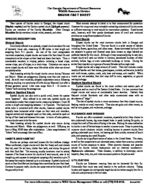The Georgia Department of Natural Resources Wildlife Resources Division
SKUNK FACT SHEET
Two species of skunks occur in Georgia; the striped skunk Most animals attempt to blend in to their environment for protection.
(Mephitis mephitis) and the Eastern spotted skunk (Spilogale putorius). However the unique and very noticeable contrasting coloration of skunks serves
Skunks are members of the Family Mustelidae. Other Georgia as sufficient warning to most would be mammalian predators. Great-horned
Mustelidae family members include minks, weasels, and otters.
owls, however, with their poorly developed sense of smell and nocturnal
activities are a significant predator of skunks.
SPECIES DESCRIPTION
Striped Skunk
Striped Skunk
Striped skunks are the most common skunks both in Georgia and
Commonly referred to as polecats, striped skunk are about the size throughout the United States. They are found in a wide variety of habitats
of domestic house cats, measuring 21-28 inches in total length and including forests, agriculture, and urban areas. Areas dominated by brush that
weighing from 3-11 pounds. As one of the most recognizable are adjacent to grassy and forested areas (also known as edge habitat) are
mammals anywhere, striped skunks are known for their black fur and preferred habitat for this skunk. Although it may occasionally dig its own den,
characteristic white stripes on their head and down their back. There is striped skunk will seek out shelter in crevices, abandoned burrows of other
considerable variation in striping patterns including a broad stripe, animals, hollow logs, or even underneath buildings or homes. During the
narrow stripe, pair of stripes, or a short stripe. Coloration can vary as winter they may den up in groups of several females with a single male.
some striped skunks will have very little white while other are almost Striped skunks eat a large amount of insects. Their diet includes a wide
completely white.
variety of beetles and their larvae, grasshoppers, crickets, earthworms, butterfly
Peak breeding activity for striped skunks occurs during February and moth larvae, spiders, snails, ants, bees and wasps, and crayfish. When
and March. Males are polygamous (having more than one mate at a insects are not available, their diet may shift to mice, vegetation, or ground
time). As with most mustelids, delayed implantation occurs following nesting bird eggs.
breeding resulting in a synchrony of births during May and June after a Eastern Spotted Skunk
64-day gestation period. Litter sizes range from 2 - 10 skunks or Spotted skunks are found in the more northern and eastern parts of
"kittens" with six being the average size.
Georgia as well as much of the Eastern United States. It is less common than
Eastern Spotted Skunk
striped skunks and occurs at considerably lower densities. Habitats they
Spotted skunks can also emit a putrid smell; hence the species frequent include farmlands and other early successional areas with an name "putorius". Also referred to as civet cats, spotted skunks are abundance of "edge."
considerably smaller than striped skunks measuring between 17 and 23 The diet of spotted skunks is more carnivorous than their striped cousins,
inches in length and weighing between 1 to 3 pounds. The black and feeding mainly on small mammals. They also eat grubs and other insects, as
white color is consistent with other skunks, however spotted skunks well as corn, grapes, and mulberries, and eggs.
typically have horizontal white stripes on their neck and shoulders,
irregular vertical and elongated spots on their sides, and white spots on NUISANCE AND DISEASE
the top of their head and between their eyes. In terms of color patterns, Skunks are often considered nuisances, especially when they choose to
no two skunks seem to be the same.
den underneath homes, dig cone-shaped holes in yards looking for grubs, or
Peak breeding activity for spotted skunks also occurs during simply the smell of their odor of being in the area. Making the area unattractive
February and March. Males are polygamous as well. Offspring are to skunks is one of the best ways to resolve nuisance issues. Steps to preventing
born in May, 50-65 days after implantation. Litters range between 1-6 nuisance skunk situations include: installing barriers to prevent skunks from
"kittens" with an average litter size of four.
getting underneath your home, not leaving pet food outside, removal of brush
piles, and spraying your yard for grubs.
HABITS AND HABITAT
Skunks are a significant carrier of rabies in the United States. This status,
Skunks are perhaps most well known for their defense strategy. as well as their propensity to use urbanized areas, makes them a serious potential
When confronted, striped skunks will face the threat, arch and elevate source of human exposure to rabies. Other zoonotic diseases and parasites
their tail, erect the tail hairs, chatter their teeth, and stomp the ground carried by skunks include leptospirosis and an intestinal roundworm-with their front feet. This warning usually convinces most to retreat, Baylisascaris columnaris. These diseases, in addition to distemper, canine
however if the threat remains the skunk will twist around, raise its tail hepatitis, fleas, ticks, lice, and mites can cause problems for pets as well.
straight up, and squeeze its anal glands spraying a foul secretion up to 15
feet away that may be detected up to a mile away. Spotted skunks will UTILIZATION
stand on their front feet and discharge their scent directly over their head. Skunks are furbearers meaning they can be harvested for their fur.
Contrary to popular myth, skunks can spray even when being held off Historically their musk was used heavily in the perfume industry. Today,
the ground by its tail.
hunters and trappers do not typically target skunks but when caught, their fur is
sold and used primarily in the trim trade.
For more information, contact a WRD Game Management Office or call (770) 918-6416. Revised 8/05
